Boyang Xia
ChorusCVR: Chorus Supervision for Entire Space Post-Click Conversion Rate Modeling
Feb 12, 2025



Abstract:Post-click conversion rate (CVR) estimation is a vital task in many recommender systems of revenue businesses, e.g., e-commerce and advertising. In a perspective of sample, a typical CVR positive sample usually goes through a funnel of exposure to click to conversion. For lack of post-event labels for un-clicked samples, CVR learning task commonly only utilizes clicked samples, rather than all exposed samples as for click-through rate (CTR) learning task. However, during online inference, CVR and CTR are estimated on the same assumed exposure space, which leads to a inconsistency of sample space between training and inference, i.e., sample selection bias (SSB). To alleviate SSB, previous wisdom proposes to design novel auxiliary tasks to enable the CVR learning on un-click training samples, such as CTCVR and counterfactual CVR, etc. Although alleviating SSB to some extent, none of them pay attention to the discrimination between ambiguous negative samples (un-clicked) and factual negative samples (clicked but un-converted) during modelling, which makes CVR model lacks robustness. To full this gap, we propose a novel ChorusCVR model to realize debiased CVR learning in entire-space.
CODER: Coupled Diversity-Sensitive Momentum Contrastive Learning for Image-Text Retrieval
Aug 21, 2022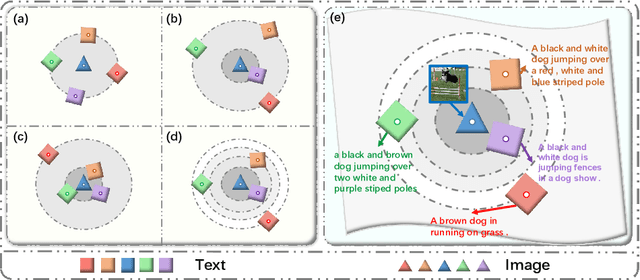
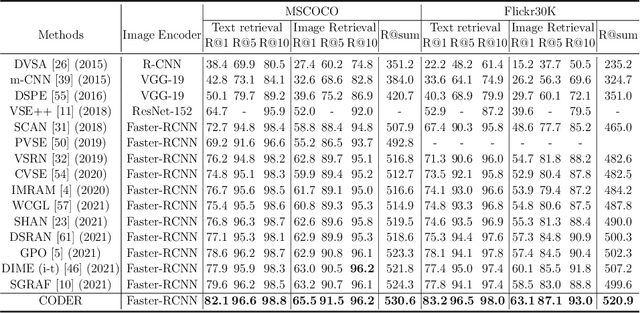
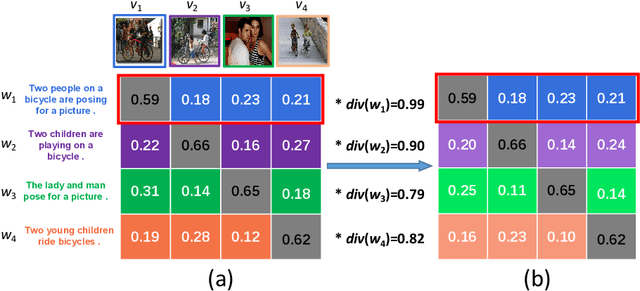
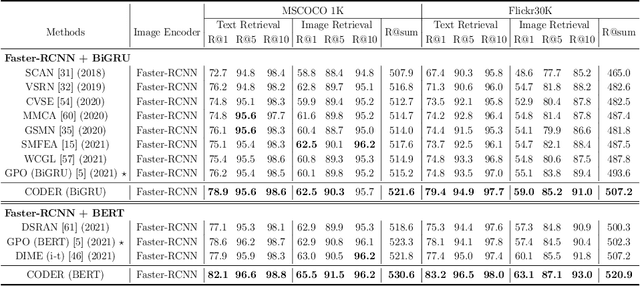
Abstract:Image-Text Retrieval (ITR) is challenging in bridging visual and lingual modalities. Contrastive learning has been adopted by most prior arts. Except for limited amount of negative image-text pairs, the capability of constrastive learning is restricted by manually weighting negative pairs as well as unawareness of external knowledge. In this paper, we propose our novel Coupled Diversity-Sensitive Momentum Constrastive Learning (CODER) for improving cross-modal representation. Firstly, a novel diversity-sensitive contrastive learning (DCL) architecture is invented. We introduce dynamic dictionaries for both modalities to enlarge the scale of image-text pairs, and diversity-sensitiveness is achieved by adaptive negative pair weighting. Furthermore, two branches are designed in CODER. One learns instance-level embeddings from image/text, and it also generates pseudo online clustering labels for its input image/text based on their embeddings. Meanwhile, the other branch learns to query from commonsense knowledge graph to form concept-level descriptors for both modalities. Afterwards, both branches leverage DCL to align the cross-modal embedding spaces while an extra pseudo clustering label prediction loss is utilized to promote concept-level representation learning for the second branch. Extensive experiments conducted on two popular benchmarks, i.e. MSCOCO and Flicker30K, validate CODER remarkably outperforms the state-of-the-art approaches.
NSNet: Non-saliency Suppression Sampler for Efficient Video Recognition
Jul 21, 2022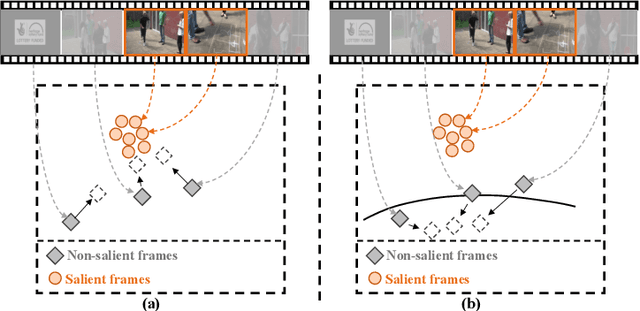
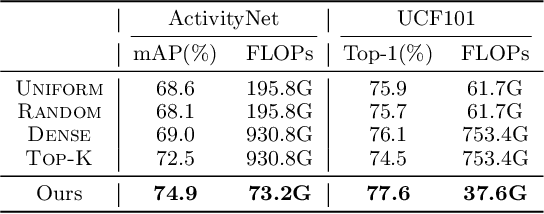
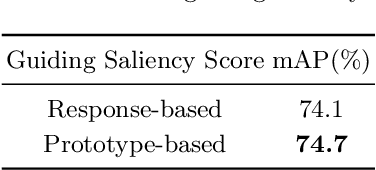
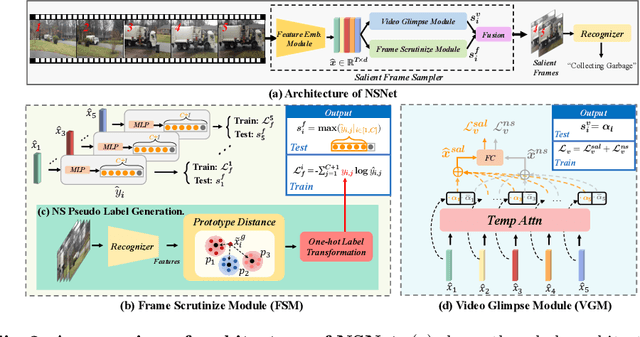
Abstract:It is challenging for artificial intelligence systems to achieve accurate video recognition under the scenario of low computation costs. Adaptive inference based efficient video recognition methods typically preview videos and focus on salient parts to reduce computation costs. Most existing works focus on complex networks learning with video classification based objectives. Taking all frames as positive samples, few of them pay attention to the discrimination between positive samples (salient frames) and negative samples (non-salient frames) in supervisions. To fill this gap, in this paper, we propose a novel Non-saliency Suppression Network (NSNet), which effectively suppresses the responses of non-salient frames. Specifically, on the frame level, effective pseudo labels that can distinguish between salient and non-salient frames are generated to guide the frame saliency learning. On the video level, a temporal attention module is learned under dual video-level supervisions on both the salient and the non-salient representations. Saliency measurements from both two levels are combined for exploitation of multi-granularity complementary information. Extensive experiments conducted on four well-known benchmarks verify our NSNet not only achieves the state-of-the-art accuracy-efficiency trade-off but also present a significantly faster (2.4~4.3x) practical inference speed than state-of-the-art methods. Our project page is at https://lawrencexia2008.github.io/projects/nsnet .
Temporal Saliency Query Network for Efficient Video Recognition
Jul 21, 2022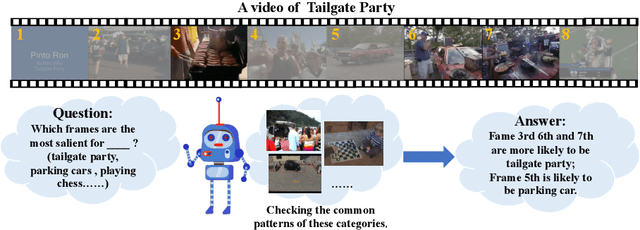

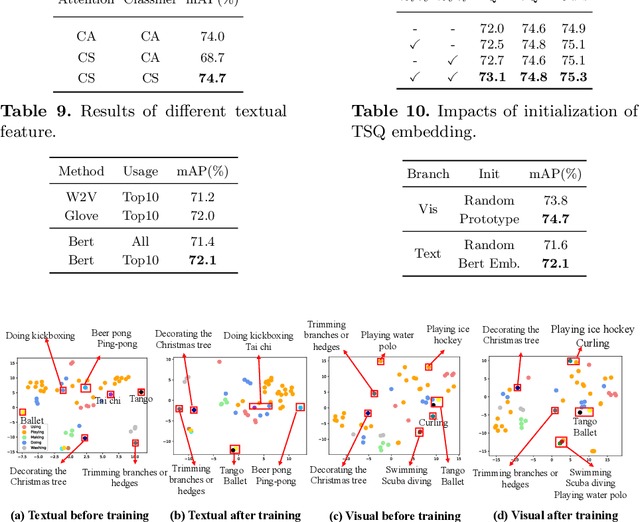
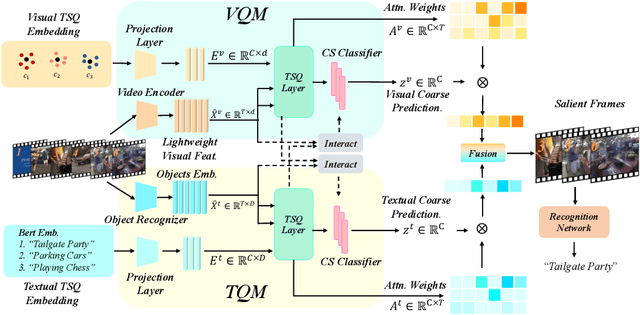
Abstract:Efficient video recognition is a hot-spot research topic with the explosive growth of multimedia data on the Internet and mobile devices. Most existing methods select the salient frames without awareness of the class-specific saliency scores, which neglect the implicit association between the saliency of frames and its belonging category. To alleviate this issue, we devise a novel Temporal Saliency Query (TSQ) mechanism, which introduces class-specific information to provide fine-grained cues for saliency measurement. Specifically, we model the class-specific saliency measuring process as a query-response task. For each category, the common pattern of it is employed as a query and the most salient frames are responded to it. Then, the calculated similarities are adopted as the frame saliency scores. To achieve it, we propose a Temporal Saliency Query Network (TSQNet) that includes two instantiations of the TSQ mechanism based on visual appearance similarities and textual event-object relations. Afterward, cross-modality interactions are imposed to promote the information exchange between them. Finally, we use the class-specific saliencies of the most confident categories generated by two modalities to perform the selection of salient frames. Extensive experiments demonstrate the effectiveness of our method by achieving state-of-the-art results on ActivityNet, FCVID and Mini-Kinetics datasets. Our project page is at https://lawrencexia2008.github.io/projects/tsqnet .
Temporal Action Proposal Generation with Background Constraint
Dec 15, 2021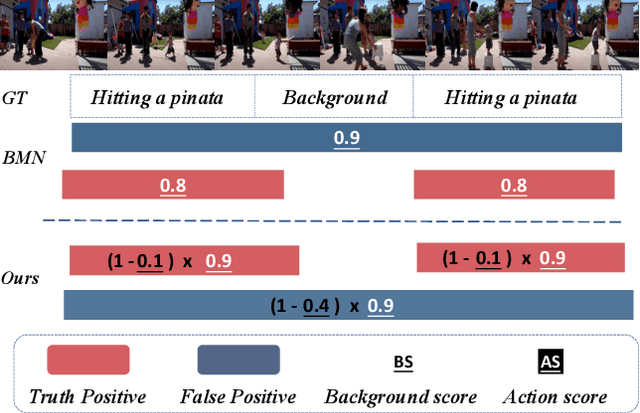
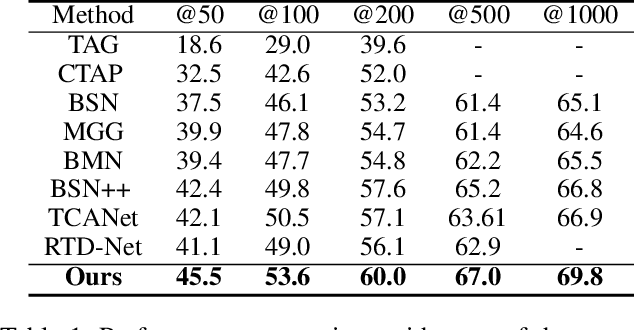
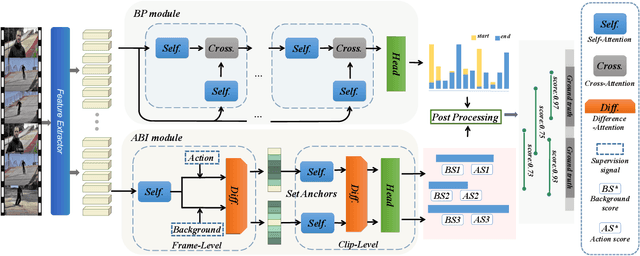
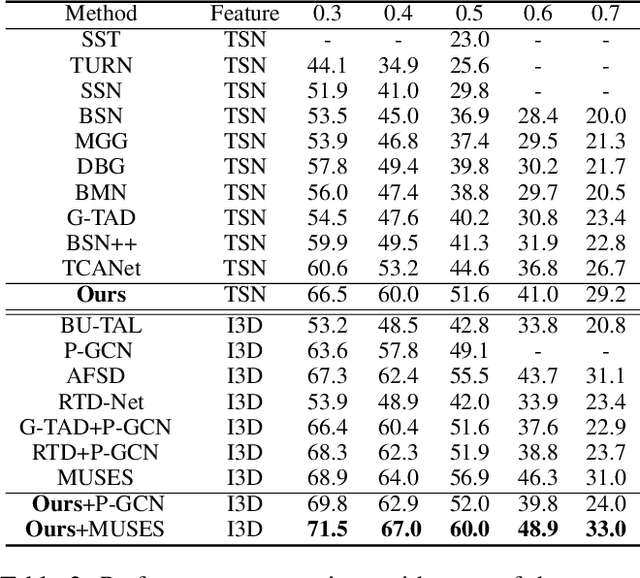
Abstract:Temporal action proposal generation (TAPG) is a challenging task that aims to locate action instances in untrimmed videos with temporal boundaries. To evaluate the confidence of proposals, the existing works typically predict action score of proposals that are supervised by the temporal Intersection-over-Union (tIoU) between proposal and the ground-truth. In this paper, we innovatively propose a general auxiliary Background Constraint idea to further suppress low-quality proposals, by utilizing the background prediction score to restrict the confidence of proposals. In this way, the Background Constraint concept can be easily plug-and-played into existing TAPG methods (e.g., BMN, GTAD). From this perspective, we propose the Background Constraint Network (BCNet) to further take advantage of the rich information of action and background. Specifically, we introduce an Action-Background Interaction module for reliable confidence evaluation, which models the inconsistency between action and background by attention mechanisms at the frame and clip levels. Extensive experiments are conducted on two popular benchmarks, i.e., ActivityNet-1.3 and THUMOS14. The results demonstrate that our method outperforms state-of-the-art methods. Equipped with the existing action classifier, our method also achieves remarkable performance on the temporal action localization task.
 Add to Chrome
Add to Chrome Add to Firefox
Add to Firefox Add to Edge
Add to Edge